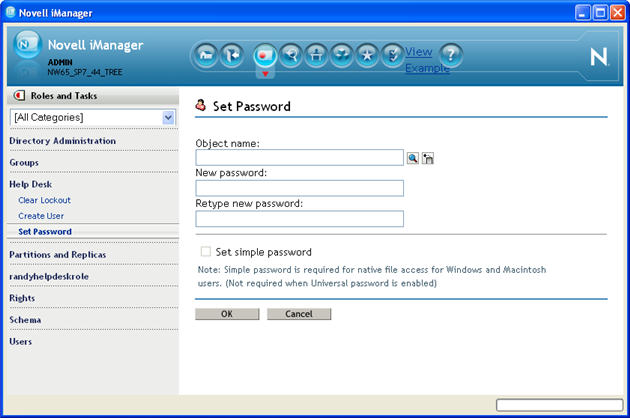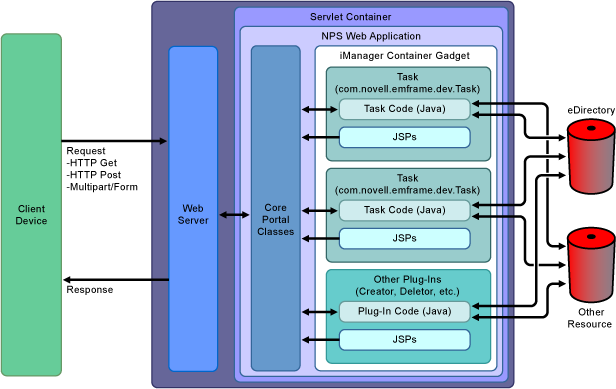2.1 How iManager Works
iManager is based on the J2EE servlet specification and runs on the Tomcat* servlet container. iManager itself is a framework for extensions called plug-ins. Tasks, property books, and property book pages are types of plug-ins.
2.1.1 Tasks
Plug-ins that perform a distinct management function, such as creating a user or setting a password, are called tasks. iManager organizes tasks by role in the Navigation frame.
Figure 2-1 Tasks in the iManager UI

In Figure 2-1, the task is selected, and the task’s UI displays in the Content frame.
Tasks consist of Java class files, Java Server Pages (JSPs), registration files, and resource files that are placed in the appropriate directories within the document root directory of the Novell Portal Services (NPS) Web Application servlet. For more information about the iManager directory structure, see Section 2.2, The iManager Directory Structure.
2.1.2 Property Books and Pages
A property book displays a group of pages that allow a user to view or modify the properties of an object or set of objects of the same type. Each page of the book has a tab that the user can click to switch to that page.
For example, a property book that modifies the attributes of User objects might have a page that allows an administrator to specify a user's login script. Another page might allow an administrator to change a user's e-mail address and telephone number.
Property books can be assigned to roles and appear in the list of tasks for a role.
Property book pages are similar to tasks. However, they are for displaying and modifying attributes in a single view. For more complex, wizard-like UI, you should create a task.
Like tasks, property book pages consist of Java class files, JSPs, registration files, and resource files that are placed in the appropriate directories within the document root directory of the NPS Web Application servlet. For more information about the iManager directory structure, see Section 2.2, The iManager Directory Structure.
2.1.3 Architecture
The following figure illustrates the iManager architecture.
Figure 2-2 The iManager 2.7 architecture

iManager tasks can use the Role-Based Services (RBS) technology product, which is part of iManager. You can use RBS to base the availability of your tasks on the user's role in an organization. For more information about RBS, see Section 2.3, Role-Based Services.
For detailed instructions on how to create iManager plug-ins, see Section 3.0, Creating Tasks.